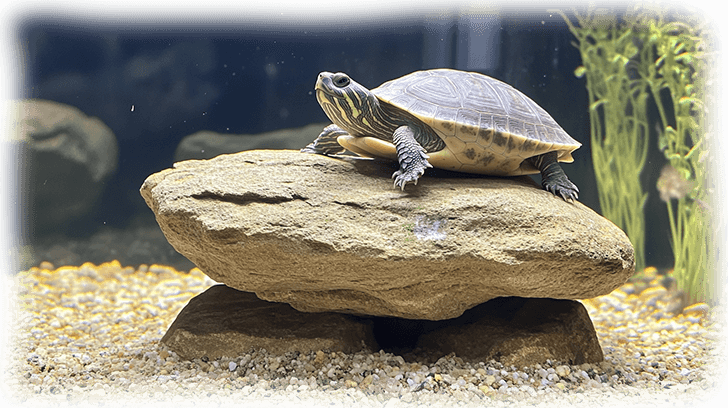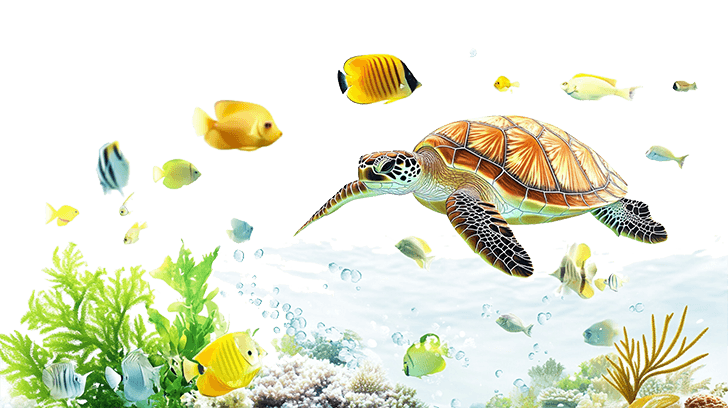Aquatic Turtles: A Comprehensive Guide to Caring for Red-Eared Sliders and More
Aquatic turtles, like the popular red-eared slider, are fascinating creatures that bring a touch of the wild into your home. While they are often seen as beginner pets, they require thoughtful care and a well-planned environment to thrive. Unlike fish, turtles need a mix of water and land to live comfortably, which makes their setup a bit more elaborate. Let’s dive into the details of their habitat, diet, health, behavior, and some interesting facts that make aquatic turtles such captivating pets.
Habitat Needs — Creating the Perfect Environment
Aquatic turtles need both water and dry land in their tank to meet their unique lifestyle. For species like red-eared sliders, a well-designed habitat should include ample swimming space as well as an area where they can bask out of the water.
- Tank Size and Water Depth — A 40-gallon tank is usually the minimum for a single adult turtle (Amazon affiliate link), though bigger is always better, especially as they grow. The depth of the water should be at least twice the length of the turtle’s shell, allowing them to fully submerge and swim freely. Keep in mind that aquatic turtles are strong swimmers, so a spacious tank with varying water depths is ideal.
- Basking Area — Turtles need a dry area where they can completely climb out of the water to bask in heat and absorb UVB rays. You can create a basking platform using smooth rocks, driftwood, or commercially available basking docks that attach to the side of the tank. Red-eared sliders, in particular, love to bask under warm light, and they will often spend hours lounging in the heat.
- Lighting and Heating — It’s essential to provide a basking light that emits both UVA and UVB rays. UVA light helps stimulate natural behaviors like feeding and mating, while UVB light is crucial for calcium absorption, which keeps their shells strong. The basking area should be maintained at a temperature between 85°F to 90°F, while the water temperature should be kept around 75°F to 80°F for adults and slightly warmer for younger turtles.
- Filtration System — Aquatic turtles are notoriously messy. They produce a significant amount of waste, which can quickly foul the water if not properly filtered. A powerful canister filter is usually recommended, as it will keep the water clean and prevent the buildup of harmful bacteria (Amazon affiliate link). Regular water changes are also a must to ensure a healthy environment.

Feeding and Diet — A Balanced Diet for Healthy Growth
Aquatic turtles like red-eared sliders are omnivores, meaning they eat both plants and animals. A well-balanced diet is essential for their growth, shell health, and overall wellbeing.
- Commercial Pellets — High-quality commercial turtle pellets should make up a significant portion of their diet (Amazon affiliate link). These pellets are formulated to provide essential vitamins and minerals, particularly calcium, which is vital for shell development.
- Fresh Vegetables — Leafy greens such as kale, collard greens, and dandelion greens are excellent choices. You can also offer vegetables like carrots, zucchini, and bell peppers. Aquatic plants like duckweed and water lettuce are good for variety.
- Protein Sources — For protein, turtles enjoy feeder fish, earthworms, crickets, and cooked meats such as shrimp or chicken (without seasoning). However, protein should be offered in moderation, especially for adult turtles, as too much can lead to health problems like kidney disease.
- Calcium — Turtles require a lot of calcium to maintain strong shells (Amazon affiliate link). Cuttlebone is an excellent calcium supplement that turtles can nibble on. It can be placed directly in the water or attached to the side of the tank.
Juvenile turtles require more protein in their diet, but as they age, their diet should shift to include more plant matter. A general rule of thumb is that young turtles should have about 70% protein in their diet, while adults should have 70% vegetation.

Behavior and Interaction — Understanding Your Turtle’s Personality
Aquatic turtles are not as social or interactive as other pets, but they do have distinct personalities and behaviors that are fascinating to observe.
- Basking Behavior — Red-eared sliders are known for their love of basking. You’ll often find them stacked on top of each other, soaking in the warmth. If your turtle spends too much time in the water and refuses to bask, it might be an indication that something is wrong with the environment, such as the basking area being too cold or the UV light not working. (Amazon affiliate link)
- Swimming and Exploring — Turtles are natural explorers. They will spend a lot of time swimming around, looking for food, or rearranging items in their tank. If your turtle is active, curious, and swimming often, it’s a good sign that they are healthy and happy.
- Interaction with Humans — While they don’t enjoy being handled as much as other pets, turtles do recognize their owners. Over time, they may even swim toward you when you approach the tank, especially if they associate you with food. It’s important to handle them gently and limit it to only necessary times, as too much handling can stress them out.

Common Health Issues — Prevention and Treatment
Like all pets, aquatic turtles can face health issues if not cared for properly. Here are a few common problems and how to prevent or manage them.
- Shell Rot — Shell rot is a bacterial or fungal infection that can cause soft spots or lesions on the turtle’s shell. It often results from unsanitary water conditions or the turtle not having access to a dry basking area. Regular tank cleanings, a strong filtration system, and a proper basking setup can prevent this. If you notice any signs of shell rot, a trip to a reptile vet is essential for treatment.
- Respiratory Infections — If a turtle is frequently gasping for air, wheezing, or has mucus around its mouth or nose, it may be suffering from a respiratory infection. This is often caused by cold water or poor ventilation. Ensuring that the water and basking temperatures are kept at proper levels is key to preventing respiratory issues.
- Vitamin A Deficiency — This can lead to swollen eyes, lethargy, and a lack of appetite. Feeding a balanced diet rich in vegetables will help prevent vitamin A deficiency.

Curious Facts About Aquatic Turtles
- Long Lifespan — With proper care, aquatic turtles like red-eared sliders can live for 20 to 30 years, making them a long-term commitment. Some turtles have even been known to live into their 40s.
- Great Swimmers — Despite their slow movements on land, aquatic turtles are fantastic swimmers. Their webbed feet and streamlined shells make them perfectly adapted to life in the water.
- Color Changes — Red-eared sliders get their name from the red stripe behind their eyes. Interestingly, as they age, their vibrant colors can fade, turning them darker or even black in some cases.
- Temperature Regulation — Turtles are ectothermic, meaning they rely on their environment to regulate their body temperature. This is why providing both warm basking areas and cooler water is so essential for their health.
In conclusion, aquatic turtles like red-eared sliders make wonderful pets for those who are willing to invest the time and effort into creating a suitable environment. From their intricate care requirements to their fascinating behaviors, turtles offer a unique glimpse into the animal kingdom. By providing the right habitat, a balanced diet, and regular maintenance, you can ensure your turtle lives a long, healthy, and happy life.
Affiliate Disclosure
This post may contain affiliate links, which means I earn from purchases made through links. Please see the privacy policy page for more details.







